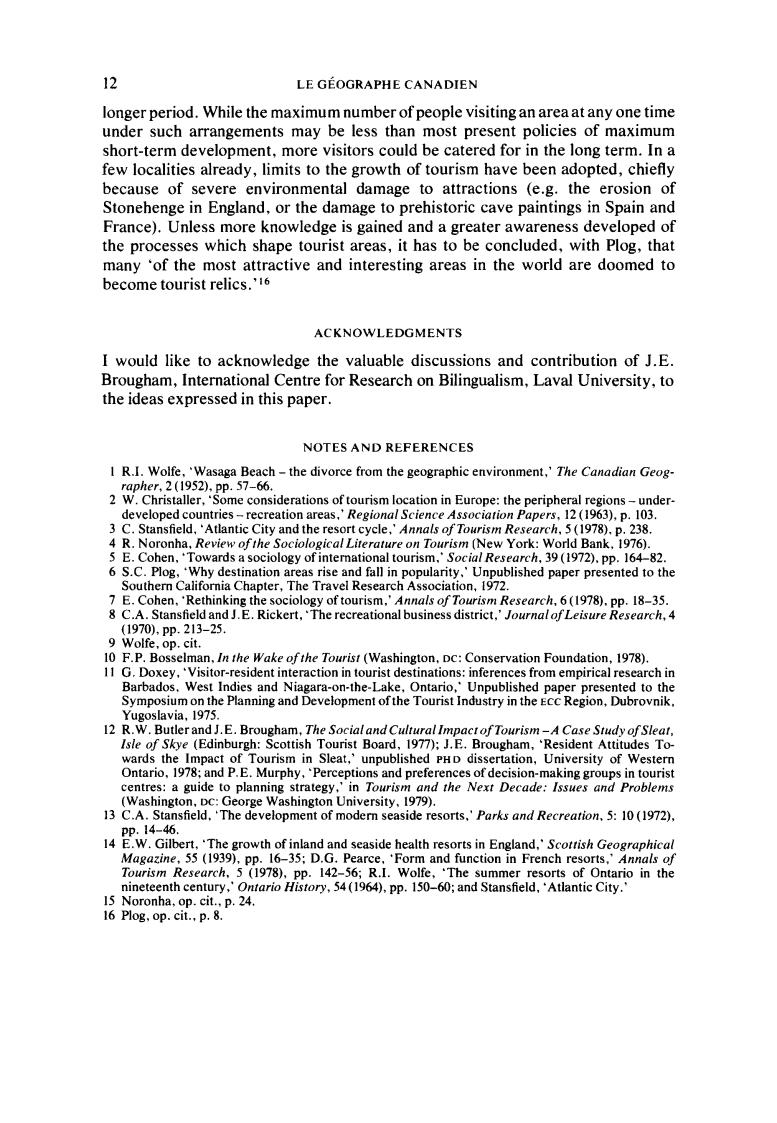正在加载图片...

12 LE GEOGRAPHE CANADIEN longer period.While the maximum number of people visiting an area at any one time under such arrangements may be less than most present policies of maximum short-term development,more visitors could be catered for in the long term.In a few localities already,limits to the growth of tourism have been adopted,chiefly because of severe environmental damage to attractions (e.g.the erosion of Stonehenge in England,or the damage to prehistoric cave paintings in Spain and France).Unless more knowledge is gained and a greater awareness developed of the processes which shape tourist areas,it has to be concluded,with Plog,that many 'of the most attractive and interesting areas in the world are doomed to become tourist relics.'16 ACKNOWLEDGMENTS I would like to acknowledge the valuable discussions and contribution of J.E. Brougham,International Centre for Research on Bilingualism,Laval University,to the ideas expressed in this paper. NOTES AND REFERENCES I R.I.Wolfe,'Wasaga Beach-the divorce from the geographic environment,'The Canadian Geog- rapher,2(19s2),pp.57-66. 2 W.Christaller,'Some considerations of tourism location in Europe:the peripheral regions-under- developed countries-recreation areas,'Regional Science Association Papers,12(1963),p.103. 3 C.Stansfield,'Atlantic City and the resort cycle,'Annals of Tourism Research.5(1978).p.238. 4 R.Noronha,Review of the Sociological Literature on Tourism (New York:World Bank,1976). 5 E.Cohen,'Towards a sociology of international tourism,'Social Research,39(1972).pp.164-82. 6 S.C.Plog,'Why destination areas rise and fall in popularity.'Unpublished paper presented to the Southern California Chapter,The Travel Research Association,1972. 7 E.Cohen.'Rethinking the sociology of tourism.'Annals of Tourism Research,6(1978).pp.18-35. 8 C.A.Stansfield and J.E.Rickert,'The recreational business district,'Journal of Leisure Research,4 (1970),Pp.213-25. 9 Wolfe,op.cit. 10 F.P.Bosselman,In the Wake ofthe Tourist(Washington,DC:Conservation Foundation,1978). 11 G.Doxey,'Visitor-resident interaction in tourist destinations:inferences from empirical research in Barbados.West Indies and Niagara-on-the-Lake,Ontario,'Unpublished paper presented to the Symposium on the Planning and Development ofthe Tourist Industry in the Ecc Region,Dubrovnik. Yugoslavia,1975. 12 R.W.Butler and J.E.Brougham,The Social and Cultural Impact of Tourism-A Case Study of Sleat, Isle of Skye (Edinburgh:Scottish Tourist Board,1977);J.E.Brougham,'Resident Attitudes To- wards the Impact of Tourism in Sleat,unpublished PHD dissertation,University of Western Ontario,1978;and P.E.Murphy,Perceptions and preferences of decision-making groups in tourist centres:a guide to planning strategy,'in Tourism and the Next Decade:Issues and Problems (Washington,DC:George Washington University,1979). 13 C.A.Stansfield,'The development of modern seaside resorts,'Parks and Recreation,5:10(1972), pp.l4-46. 14 E.W.Gilbert,'The growth of inland and seaside health resorts in England,'Scotrish Geographical Magazine,55 (1939),pp.16-35:D.G.Pearce,'Form and function in French resorts,'Annals of Tourism Research.5 (1978),pp.142-56;R.I.Wolfe,'The summer resorts of Ontario in the nineteenth century,'Ontario History,54(1964),pp.150-60;and Stansfield,'Atlantic City.' 15 Noronha,op.cit.,p.24. 16 Plog,op.cit..p.8.12 LE GEOGRAPHE CANADIEN longer period. While the maximum number of people visiting an area at any one time under such arrangements may be less than most present policies of maximum short-term development, more visitors could be catered for in the long term. In a few localities already, limits to the growth of tourism have been adopted, chiefly because of severe environmental damage to attractions (e.g. the erosion of Stonehenge in England, or the damage to prehistoric cave paintings in Spain and France). Unless more knowledge is gained and a greater awareness developed of the processes which shape tourist areas, it has to be concluded, with Plog, that many ‘of the most attractive and interesting areas in the world are doomed to become tourist relics.’ l6 ACKNOWLEDGMENTS I would like to acknowledge the valuable discussions and contribution of J.E. Brougham, International Centre for Research on Bilingualism, Laval University, to the ideas expressed in this paper. NOTES AND REFERENCES I R.I. Wolfe, ‘Wasaga Beach - the divorce from the geographic environment,’ The Canadian Geographer, 2 (1952), pp. 57-66. 2 W. Christaller, ‘Some considerations of tourism location in Europe: the peripheral regions - underdeveloped countries - recreation areas,’ Regional Science Association Papers, 12 (1963), p. 103. 3 C. Stansfield, ‘Atlantic City and the resort cycle,’ Annals of Tourism Research, 5 (1978), p. 238. 4 R. Noronha, Review of the Sociological Literature on Tourism (New York: World Bank, 1976). 5 E. Cohen, ‘Towards a sociology of international tourism,’ SociulResearch, 39 (1972), pp. 164-82. 6 S.C. Plog, ‘Why destination areas rise and fall in popularity,’ Unpublished paper presented to the 7 E. Cohen, ‘Rethinking the sociology of tourism,’ Annals of Tourism Research, 6 (1978). pp. 18-35. 8 C.A. Stansfield and J.E. Rickert, ‘The recreational business district,’ JournalofLeisureResearch, 4 9 Wolfe, op. cit. 10 F.P. Bosselman, In the Wake of the Tourist (Washington, DC: Conservation Foundation, 1978). 1 I G. Doxey, ‘Visitor-resident interaction in tourist destinations: inferences from empirical research in Barbados, West Indies and Niagara-on-the-Lake, Ontario,’ Unpublished paper presented to the Symposium on the Planning and Development of the Tourist Industry in the ECC Region, Dubrovnik, Yugoslavia, 1975. 12 R.W. Butler and J.E. Brougham, The SocialandCulturaIImpactof Tourism -A CaseStudyofSleat, Isle of Skye (Edinburgh: Scottish Tourist Board, 1977); J.E. Brougham, ‘Resident Attitudes Towards the Impact of Tourism in Sleat,’ unpublished PHD dissertation, University of Western Ontario, 1978; and P.E. Murphy, ‘Perceptions and preferences of decision-making groups in tourist centres: a guide to planning strategy,’ in Tourism and the Next Decade: Issues and Problems (Washington, DC: George Washington University, 1979). 13 C.A. Stansfield, ’The development of modem seaside resorts,’ Parks andRecreation, 5: 10 (1972), 14 E.W. Gilbert, ‘The growth of inland and seaside health resorts in England,’ Scottish Geographical Magazine, 55 (1939), pp. 16-35; D.G. Pearce, ‘Form and function in French resorts,’ Annals of Tourism Research, 5 (1978), pp. 142-56; R.I. Wolfe, ‘The summer resorts of Ontario in the nineteenth century,’ Ontario History, 54 (1964), pp. 150-60; and Stansfield, ‘Atlantic City.’ Southem California Chapter, The Travel Research Association, 1972. (1970). pp. 213-25. pp. 14-46. 15 Noronha, op. cit., p. 24. 16 Plog, op. cit., p. 8